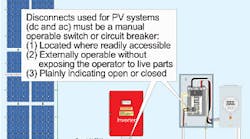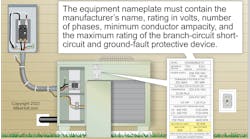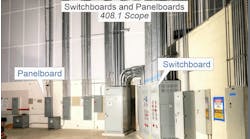Note: The requirements outlined in this article are based on the 2011 edition of the NEC.
We concluded Part 1 of this topic with the requirements for the service disconnects of solar photovoltaic (PV) systems. As we continue to discuss Part III of Art. 690 (Disconnecting Means), we come to the topic of requirements for the equipment disconnects.
Equipment disconnects are for such things as inverters, batteries, and charge controllers. These disconnects must disconnect equipment from all ungrounded conductors of all sources. If the equipment is energized from more than one source, such as an inverter, the disconnecting means for all sources must be grouped and identified [690.15].
Fuses
It’s necessary to provide a means to disconnect a fuse from all sources of supply, if energized from both directions. The fuse must be capable of being disconnected independently of fuses in other PV source circuits [690.16(A)]. Using disconnects with pull-out fuses is one method to disconnect a fuse from all sources of energy.
Disconnects for fuses must be installed for PV output circuits where fuses that must be serviced can’t be isolated from energized circuits. The disconnect must be:
- Within sight of, and accessible to, the fuse (or integral with the fuse holder).
- Externally operable without exposing the operator to contact with live parts.
- Plainly indicating whether in the open or closed position [690.16(B)].
If the disconnect is more than 6 ft from the fuse, then you must install a directory showing the location of the fuse disconnect at the fuse location. Non-load-break rated disconnects must be marked “Do not open under load.”
A disconnect for PV systems — direct current (DC) and alternating current (AC) — must be a manually operable switch or circuit breaker complying with all of the following (Fig. 1):
- Readily accessible [690.14(C)(1)]
- Externally operable without exposing the operator to contact with live parts.
- Plainly indicating whether in the open or closed position.
- Have an interrupting rating sufficient for the nominal circuit voltage and the current available at the line terminals of the equipment.
Where all terminals of a disconnect may be energized when the switch is open, a warning sign must be placed on (or adjacent to) the disconnect.
Wiring methods
Part IV of Art. 690 covers wiring methods, and begins by stating that NEC Chapter 3 wiring methods and other wiring systems specifically identified for use on PV systems are allowed to be used [690.31(A)]. However, PV source and output circuits above 30V must be installed in a raceway if the conductors are readily accessible.
Single-conductor Type USE-2 or listed and labeled PV wire can be run exposed at outdoor locations for PV source circuits. But if the circuit is more than 30V, single-conductor Type USE-2 or listed and labeled PV wires must not be accessible from a readily accessible location [690.31(B) and Ex].
If you run DC input PV system conductors and AC inverter output conductors inside a building or structure, run them in metal raceway, Type MC cable, or metal enclosure [690.31(E)]. Additional installation requirements apply, which were added in the 2011 NEC to 690.31(E), including:
- Beneath roofs. Wiring methods for PV system conductors aren’t permitted within 10 in. of the roof decking or sheathing except where located directly below the roof surface that’s covered by PV modules and associated equipment. Wiring methods for PV system conductors must be run perpendicular (90°) to the roof penetration point. Note: The 10 in. from the roof decking/sheathing requirement is to prevent accidental contact to energized conductors from saws used by firefighters for roof ventilation during a structure fire.
- Flexible wiring methods. Flexible metal conduit smaller than trade size ¾ or Type MC cable smaller than 1 in. in diameter installed across ceilings or floor joists must be protected by substantial guard strips that are at least as high as the wiring method. Where runs are exposed, other than within 6 ft of their connection to equipment, wiring methods must closely follow the building surface or be protected from physical damage by an approved means.
- Marking or labeling required. Wiring methods and enclosures containing PV source conductors must be marked with the wording “Photovoltaic Power Source” by labels or other approved permanent marking means suitable for the environment and placed with a maximum of 10 ft of spacing.
System grounding
To limit the voltage induced by lightning, one conductor of a 2-wire PV system operating at more than 50V must be solidly grounded (connected to the earth) per 250.4(A)(1) [690.41]. The grounding connection can be at any single point on the grounded conductor of the PV DC output circuit [690.42]. PV systems with ground-fault protection that incorporates the system grounding connection must not have an additional grounding connection [690.42 Ex].
Equipment grounding (bonding)
Connect all exposed metal parts of PV module frames, electrical equipment, raceways, and enclosures to an equipment grounding conductor (EGC) of a type permitted in 250.118 [250.134 and 690.43(A)], as shown in Fig. 2. You must install an EGC between the PV array and associated equipment [690.43(B)]. Devices listed and identified for grounding the metallic frames of PV modules and associated equipment can be used to bond the exposed metal surfaces of modules and equipment to the metal racks [690.43(C)].
Metallic mounting racks used as an EGC must be identified as an EGC or have identified bonding jumpers/devices connected between the separate metallic racks and be connected to an EGC as required by 690.43(A). Devices and systems used for securing PV modules to metal mounting racks that serve as an EGC must be identified for such purposes [690.43(D)]. Devices identified and listed for bonding the metallic frames of PV modules can be used to bond the metallic frames of PV modules to the metallic frames of adjacent PV modules [690.43(E)]. All conductors of a circuit, including the EGC, must be installed in the same raceway or cable, or otherwise run with the PV array circuit conductors when they leave the vicinity of the PV array [690.43(F)].
For PV circuits having overcurrent protection, size the EGC to the rating of the PV circuit overcurrent protective device (OCPD) per Table 250.122 [690.45(A)]. Where no overcurrent protection is provided for the PV DC circuit, as permitted in 690.9 Ex., size the EGC to the PV circuit short circuit current rating per Table 250.122 [690.45(A)].
Grounding electrode system
If installing a DC system, provide a grounding electrode system per 250.166 with a grounding electrode conductor per 250.64. A common DC grounding-electrode conductor can serve multiple inverters with the common grounding electrode and the tap conductors sized per 250.166. A splice or joint is not allowed in the common grounding electrode conductor [250.47(B)].
PV systems with DC modules having no direct connection between the DC grounded conductor and the AC grounded conductor must be bonded to the AC grounding system by one of the
methods listed in 690.47(C)(1), (2), or (3). This set of requirements is new, with the 2011 NEC:
- A separate DC grounding electrode bonded to the AC grounding electrode system with a bonding jumper sized to the larger of the existing AC grounding electrode conductor or DC grounding electrode conductor specified by 250.166 (Fig. 3).
- A DC grounding electrode conductor sized to 250.166 run from the marked DC grounding electrode connection point to the AC grounding electrode. Where an AC grounding electrode isn’t accessible, the DC grounding electrode conductor is permitted to terminate to the AC grounding electrode conductor by irreversible compression-type connectors listed as grounding and bonding equipment or by the exothermic welding process [250.64(C)(1)].
- An unspliced, or irreversibly spliced, combined equipment grounding/grounding electrode conductor run from the marked DC grounding electrode connection point along with the AC circuit conductors to the grounding bus bar in the associated AC equipment (Fig. 4).
Install bonding jumpers around equipment so that you maintain the bonding continuity if the equipment is removed [690.48 and 690.49]. This applies to exposed conducting surfaces of PV equipment and to the PV system grounded conductor.
Power source label
Apply a permanent label at the PV DC disconnect indicating [690.53]:
- Rated maximum power-point current (Imp)
- Rated maximum power-point voltage (Vmp)
- Maximum system voltage (Voc)
- Short circuit current (Isc)
- Maximum rated output current of the charge controller (if installed).
For interactive systems, the point of interconnection of the PV system power source to other sources must be marked at an accessible location at the disconnect as a power source and with the rated AC output current and nominal operating AC voltage [690.54].
Any building or structure with a standalone PV system not connected to a utility service source must have a permanent plaque on the exterior of the building or structure, at a readily visible location. It must indicate the location of the standalone PV system disconnect and that the structure contains a standalone electrical power system [690.56(A)].
Any structure containing both utility service and a PV system must have a permanent plaque identifying the location of the service disconnect and PV system AC disconnect (if they are not at the same location) [690.56(B)].
Connection to other sources
For interactive systems, use only inverters and AC PV modules listed as interactive [690.60]. An inverter or an AC module in an interactive PV system must automatically de-energize its output to the electrical distribution system upon loss of voltage. It must remain de-energized until the electrical distribution system voltage has been restored [690.61].
Article 705 of the NEC covers interconnected electric power production sources. There are requirements in Art. 705 that apply to solar voltaic systems.
Storage batteries
Install storage batteries per Art. 480 [690.71(A)]. Additionally:
- For dwellings, the cells must be series connected (to operate at less than 50V, nominal) [690.71(B)].
- Live parts of storage battery systems for dwellings shall be guarded to prevent accidental contact by persons or objects, regardless of voltage.
- Install listed current-limiting overcurrent devices where the available short circuit current from the battery bank exceeds the interrupting or withstand ratings of equipment it supplies.
- Where used for battery interconnections, flexible cables identified for hard-service use and moisture resistant as identified in Art. 400 must be a minimum size of 2/0 AWG. You can use flexible cables only between the battery terminals to a nearby junction box (where they must connect to an approved wiring method) or between batteries and cells within the battery enclosure [690.74].
- Where used for battery interconnections, flexible, fine-stranded cables must terminate in terminals, lugs, devices, or connectors that are identified and listed for fine-stranded conductors [110.14(A) and 690.74].
The production of power from solar resources is not a new concept, but it is an area of ever-changing technology and strong growth. The NEC requirements for these systems have also changed; therefore, the solar installer must keep current with the Code requirements.




